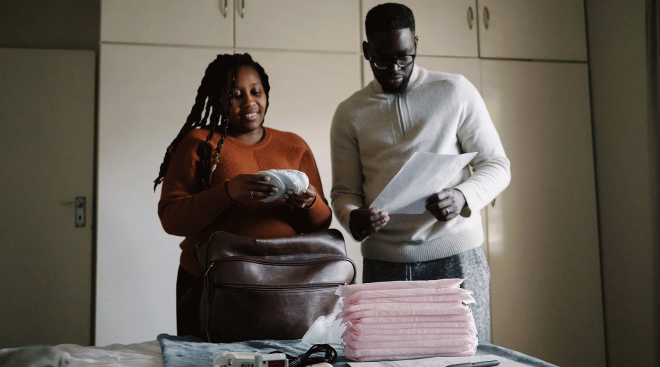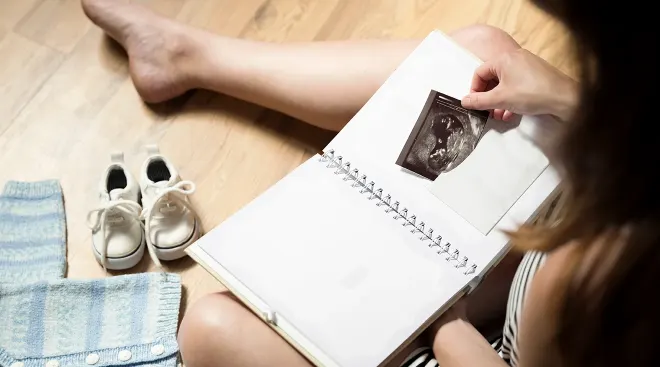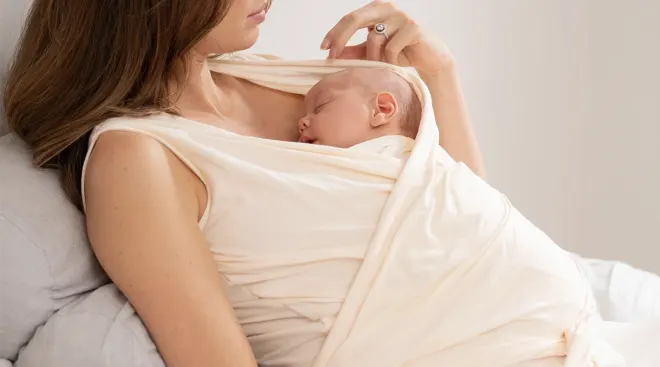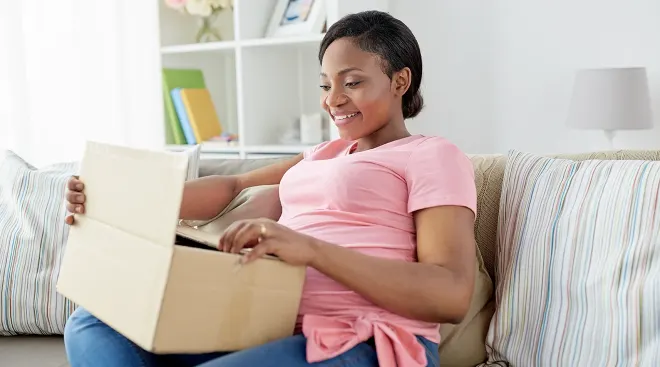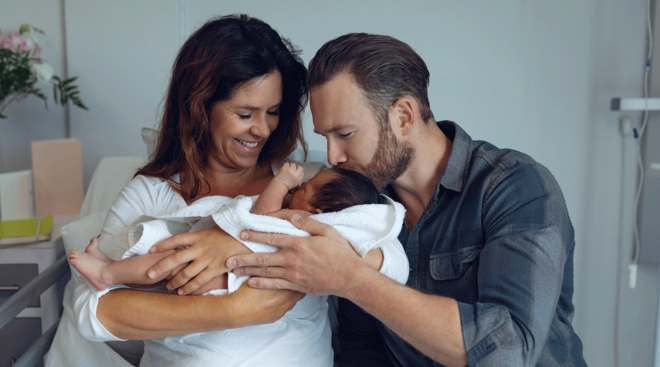- Another new symptom that might crop up soon? Darker nipples. Hormonal changes can make your areolas look different. This is believed to be an evolutionary phenomenon to help baby find them for breastfeeding.
- Speaking of boobs—are they a tad bit leaky? Your breasts are definitely bigger and they may even started making colostrum, a thick and highly beneficial yellow fluid that breastfeeding babies will eat in the first few days of life.
- It’s still a bit too early for baby to arrive—although it’s important to look for signs of preterm labor. That said, baby weighs approximately 4 pounds around now.
- Baby should hopefully be dropping lower into your pelvis soon. Ideally, they’ll be head down in position, ready for birth! If your OB or midwife tells you they’re breech, don’t panic. There’s time for them to move, and your provider will walk you through options.
Week 33 of pregnancy is a good time to start packing your hospital bag. You might also want to read up on postpartum care and stock your medicine cabinet with some essential new mom care supplies. Sure, you might not see baby for another month or so, but if you have an early surprise arrival, at least you won’t have to think about which shirt to pack or whether or not you have hemorrhoid cream at home. (About that…sorry.)
By 33 weeks, baby’s brain and nervous system are completely developed and control some bodily functions. At this stage, baby’s brain has electrical activity in the sensory parts of the cerebral cortex. That said, the cerebral cortex—which is responsible for thinking, feeling, decision-making and voluntary actions—is the last part of the brain to mature. In fact, this rational part of the brain won’t be fully matured until your child is about 25 years old!
Right now, baby’s liver is stashing away iron from the foods you eat, so order a steak with a side of leafy greens. Iron helps your body make hemoglobin, which moves oxygen via red blood cells throughout the body. If you’re planning to breastfeed, breast milk is low on iron. But most babies are born with enough iron in their bodies to last them for the next six months—or about the time they’ll start eating iron-rich solid foods.
While baby’s bones are hardening, they remain soft and flexible. At birth, babies have five separate skull bones, which are separated by connective tissue known as fontanelles (soft spots). This allows your baby’s head to shape-shift to fit through the birth canal. By the time baby is 12 to 18 months old, those soft spots will have hardened and disappeared.
How big is baby at 33 weeks?
At 33 weeks pregnant, baby is as big as a head of celery. They weigh about 4.2 pounds and measure about 17.2 inches.
33 weeks pregnant is how many months?
Thirty-three weeks pregnant is just over eight months pregnant, although most doctors refer to your progress in pregnancy by week, not month.
33 week ultrasound
If you were to have a 33 weeks pregnant ultrasound, you’d see that baby is keeping their eyes open while awake. A 33 weeks pregnant ultrasound might be done as part of a biophysical profile (BPP). This test is done in the third trimester for high-risk patients (so if you’re 33 weeks pregnant with twins, you might be getting these every so often) and after 40 weeks for women who go past their due dates. The ultrasound will gauge your 33-week fetus’s movement, breathing, muscle tone and amount of amniotic fluid. The other part of the BPP—the non-stress test—will measure how baby’s heart rate changes when they move or you have contractions.
Think of it as an extra peek to confirm all is well with your 33-week baby. Maybe the peace of mind will help you with that whole relaxing thing.
If we had to sum up 33 weeks pregnant symptoms in one word? Discomfort! Here’s what you’re probably feeling this week.
Overheating
You’re one hot mama-to-be, likely because baby is radiating body heat.
Headaches
Hormone fluctuations at 33 weeks can cause headaches. So can stress or dehydration, so try to take it easy and drink plenty of water. A few extra trips to the ladies’ room is worth the sacrifice.
Shortness of breath
By now, you may be used to not being able to fully catch your breath (especially if you’re 33 weeks pregnant with twins). Imagine what a relief it will be when baby “drops” and frees up some space around your lungs. For different moms-to-be, this happens at different times, but chances are, it could be very soon.
Forgetfulness and clumsiness
This is the unproven phenomenon also known as "pregnancy brain." Your flightiness may be less due to your physiological changes and more due to the stress and anxiety of expecting baby in less than two months.
What should you be feeling at 33 weeks pregnant?
Have you been gripped with an overwhelming desire to clean your house or get all of baby’s onesies and diapers organized in the nursery? You’re nesting, an impulse that takes over in the final weeks of your pregnancy as you prepare for your new little arrival. The only thing slowing you down, aside from those 33 weeks pregnant symptoms? Lack of sleep, which is common in the third trimester. There are a number of possible causes, ranging from a full bladder to an active and kicking baby. Take care of yourself and rest when you can!
By 33 weeks pregnant, you may have gained around 22 to 28 pounds total—32 to 42 pounds if you’re 33 weeks pregnant with twins. For some moms-to-be, having some extra curves makes them feel sexy. Know that as long as your doctor has said sex is okay during your pregnancy, you can continue to enjoy it right up until delivery day.
If you feel your belly tightening occasionally, you’re probably having Braxton Hicks contractions. Here’s how you know: Braxton Hicks aren’t painful and often happen after sex or exercise. They’re different from regular contractions because they stop when you switch positions. Real contractions keep going at regular intervals—and once they're every five minutes for at least an hour, it's time to call your provider.
At 33 weeks pregnant, cramping like you’d have with a period could be a sign of preterm labor. So can vaginal bleeding, unusual discharge or leaking. At 33 weeks pregnant, pressure in your pelvis could be a sign too. Be on the lookout for these symptoms. If anything worries you, empty your bladder, lie on your left side, drink water and call your OB immediately.
What position is baby in at 33 Weeks?
It’s almost go time, so baby is likely positioned head down, or will be very soon. A 33-week fetus is also making its way toward your pelvis, so you may feel like your belly has “dropped” lower. Some babies wait until the last minute to make this move, however, so don’t worry if you don’t feel any changes.
Can you have a baby at 33 weeks?
It’s early still, so at this point having real contractions would be considered preterm labor for a baby at 33 weeks along. Certain complications and conditions make you more likely to go into labor early, such as having excess amniotic fluid or being 33 weeks pregnant with twins.
Sleep might feel like a lost cause as you try to get comfortable and deal with all of the other pregnancy symptoms that seem to surface at night (thanks a lot, heartburn!). But sleep in your final trimester is more important than ever, as you prepare for the arrival of your little one—so you want to do your best to get quality sleep at night or during the day if you can squeeze in a nap… Try using a pregnancy pillow that’ll support your back and knees, and will help you stay on your side, which is the safest position for sleep in the third trimester.
Here are some ways to show yourself some love at 33 weeks pregnant.
Use a cold compress
Apply one of these to the back of your neck to relieve headaches without medication. Bonus: A cold compress will also cool you down when you’re feeling super hot. Refreshing!
Keep your cool
And speaking of overheating, you may want to invest in a portable cooling device, especially if you're at 33 weeks during the hot-weather months. It can be anything from a desktop air conditioning unit that plugs into an outlet to a battery-powered, handheld fan you carry with you for a quick blast of cool air.
Increase your odds of a good night’s sleep
If you feel fatigued and forgetful during the day, create a bedroom environment that invites sweet sleep. Try a white noise machine or light-blocking window coverings, or spritz calming lavender essential oil onto your sheets. Needless to say, set your thermostat so the room is nice and cool, and you won’t lose sleep sweating through the night!
Take notes
You’ve got a lot on your plate right now, so don’t let anything slip through the cracks because of #PregnancyBrain. Write everything down, whether it’s in a to-do list or a digital calendar app on your phone.
Frequently Asked Questions
What essentials should I pack in my hospital bag?
Every parent’s hospital bag looks a bit different—and if it’s your first time delivering, you’ll probably overpack. You’ll want to start prepping your bag at least three weeks before your due date.
Be sure to include a couple of loose and comfortable outfits for you (including an open-front robe or shirt and nursing bra, if you’re planning to breastfeed), a couple of packs of heavy-duty pads, extra underwear (including a few pairs of disposable panties) and anything else you’d like for comfort and entertainment (toothbrush, toothpaste, hair brush, a magazine). Make sure to include your hospital admission forms, your photo ID and your birth plan (if you’re making one). For baby, pack a coming home outfit, including warm socks and a hat, and a car seat. And don’t forget a phone charger!
Are there ways to naturally get a breech baby into position?
If your baby isn’t in the heads-down position by about now, try not to worry—many babies flip-flop for the next few weeks. The vast majority of breech babies will turn by week 36 all on their own.
There isn’t any good science proving it’s possible to encourage your baby into position. But you can play music by the bottom of your uterus (hoping baby will turn toward the noise), place something cold near the top of the uterus near baby’s head (so they’ll turn away) or try one of a few yoga positions (all fours on your hands and knees, bridge pose and child’s pose).
When should I start to plan my maternity leave?
If you haven’t already, talk to your company’s human resources department ASAP about planning your maternity leave. Your HR rep will share various family leave policies, including whether the company offers paid family leave or if it qualifies for unpaid leave under the Family and Medical Leave Act (FMLA)—not all companies do. You’ll need to provide your employer with at least 30 days’ notice if you plan to take advantage of FMLA, as long as it’s possible to do so. Depending on where you live, you may qualify for your state’s paid or unpaid leave laws.
You’ll also want to schedule a meeting with your boss as soon as possible. You can discuss what you’re working on, who can cover FOR you and an initial plan for easing you back into work when you get back.
What baby essentials do I need to have before baby is born?
Buying for your first baby can feel stressful, but try not to let the barrage of advice and advertisements overwhelm you. One critical item: A car seat (you can’t take baby home from the hospital without one). Otherwise the basic essentials are (mostly) common sense: a decent supply of newborn diapers, at least six sets of PJs, several bodysuits, a couple of cardigans, socks or booties, a weather-appropriate hat a snowsuit (if it’s cold), a baby sleep space with a firm mattress, a couple of tight-fitting sheets and perhaps a sleep sack or swaddle. You’ll likely also want to buy a stroller, along with gear to breastfeed and/or bottle-feed (think: a pump, nursing bra, a bottle, a bottle brush and formula).
What do I need to know about preterm labor at week 33?
Babies who are born at week 33 are considered moderately preterm and have very good odds of survival, although health risks increase the earlier a baby is born. If you’re at significant risk for preterm birth—for example, because you delivered early in a past pregnancy—your practitioner may offer you progesterone now to reduce the risks of preterm labor.
Be sure to ask your practitioner about signs of preterm labor. One major sign is contractions that are regular and get stronger and more frequent (every 10 minutes or less). Other signs include pelvic pressure, low back pain, abdominal cramps and an increase or change in vaginal discharge (especially if it’s bloody). Let your practitioner know right away if you think you might be in labor; if birth is imminent, they may offer you medications to improve baby’s health, such as corticosteroids to help their lungs mature.
I knew from the start I wanted an epidural and a doula. I wanted the option for pain management but loved the idea of having a coach and advocate to help me through labor. I asked my OB for recommendations and interviewed a few to find the best fit. Full disclosure, she was as much for me as she was for my husband! She was great with both of us during all 20 hours of my first labor.
Please note: The Bump and the materials and information it contains are not intended to, and do not constitute, medical or other health advice or diagnosis and should not be used as such. You should always consult with a qualified physician or health professional about your specific circumstances.
American Pregnancy Association, Breast Changes During Pregnancy
March of Dimes, Signs and Symptoms of Preterm Labor, December 2020
American Pregnancy Association, 33 Weeks Pregnant
Kaiser Permanente, Pregnancy: Dropping (Lightening), July 2023
Cleveland Clinic, Breech Baby, October 2021
Kaiser Permanente, Packing Your Bag for Delivery Day
American Journal of Obstetrics & Gynecology, Patterns of Fetal Breathing Activity in the Human Fetus at 24 to 28 Weeks of Gestation, February 1988
Allina Health, Second Trimester: Your Growing Baby, December 2021
March of Dimes, Signs and Symptoms of Preterm Labor, December 2020
Mayo Clinic, Fetal Development: The 3rd Trimester, June 2022
Cleveland Clinic, Fetal Development, March 2023
Lamaze International, How Far Along Are You? Counting Pregnancy by Weeks, Months & Trimesters, September 2021
Brain and Behavior, Fetal Eye Movements in Response to a Visual Stimulus, August 2020
Johns Hopkins Medicine, Biophysical Profile: BPP Ultrasound and Nonstress Test
Johns Hopkins Medicine, The Third Trimester
American Pregnancy Association, Headaches in Pregnancy
Children's Hospital at Montefiore, Pregnancy: Dropping (Lightening), July 2023
Scientific Reports, The Effect of Pregnancy on Maternal Cognition, June 2021
American Pregnancy Association, Nesting During Pregnancy
Sleep Foundation, Sleeping While Pregnant: Third Trimester, March 2023
Nutrition During Pregnancy (US Institute of Medicine Committee on Nutritional Status During Pregnancy and Lactation), Weight Gain in Twin Pregnancies, 1990
March of Dimes, Sex During Pregnancy, February 2023
StatPearls, Braxton Hicks Contractions, August 2023
Cleveland Clinic, Stages of Labor, April 2022
March of Dimes, Preterm Labor and Premature Birth: Are You at Risk?, March 2018
Sleep Foundation, How to Sleep Better While Pregnant, March 2023
Mayo Clinic, Polyhydramnios, April 2023
Johns Hopkins Medicine, Headaches in Early Pregnancy
Learn how we ensure the accuracy of our content through our editorial and medical review process.
Navigate forward to interact with the calendar and select a date. Press the question mark key to get the keyboard shortcuts for changing dates.




































